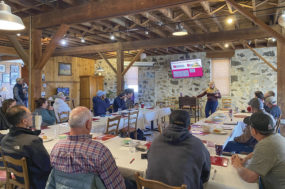Idaho is suffering one of the state’s most extreme droughts since the 1920s, depleting the reservoirs, forcing producers to shut irrigation systems off early and households to conserve water usage – and forecasters predict the dry spell is likely to continue.
This water scarcity adversely impacts industries and households throughout Idaho. Corporations in the Treasure Valley have had to reach deeper into their pockets for resources and disaster preparation as costs for water and other inputs skyrocket. Utility companies have also been forced to adapt to their losses by raising customer rates, not to mention the strain on the power system. Compounding these challenges, consumers are left paying more for food, energy and their own domestic water supply, too.
All that said, there’s no question the drought’s greatest impact has been on the state’s agricultural sector – a critical part of Idaho’s economy that accounts for one in every eight jobs and $26 billion in sales annually. The industry is now facing major losses to their yield and possibly their pocketbooks as well.
This year, many Idaho farm producers ran out of their main system irrigation water early, forcing them to use backup systems and pay higher prices for water via pumping costs from supplemental wells or perhaps purchasing water from other farms nearby. Effectively, this may lead to higher crop prices for some commodities, but many growers have seen crop yields fall between 30% and 70% of what they might have harvested if the year had brought more rainfall and a more manageable heat index.
Weather has always been a major determinant in yield outlook for farmers, but local growers can prepare for anticipated droughts by implementing proactive preparation along with the funding to make changes. As an example, investing in an efficient irrigation system can improve resilience to dry conditions while also creating more uniform crops and limiting water loss. Technologies such as drip irrigation and low-pressure sprinkler systems can reduce run-off and evaporation to help conserve water supply. These systems can also offer more fertilizer and other chemical efficiencies as well. Irrigation applications can be fine-tuned to meet crop-specific needs which may vary by soil characteristics, evapotranspiration rates and crop rotation factors. Minimum tillage or “no-till” practices can also play a role in water conservation.
Many producers are also looking at diversifying cropping systems. Idaho has a broad variety of crops that vary in water needs. Onions, sugarbeets, potatoes and hops typically deliver higher profits but come with hefty resource requirements, while wheat and barley, and some seed crops like alfalfa, bean, lettuce or turnip seed may help offset costs because they require less water and other resources. Affording the switch to a new crop is much more manageable (and less risky) with a contract with a seed company or other buyer. But not all contracts are created equal. Deciding whether a contract makes sense for each producer is critical to ensure a payday in the long run.
Agriculture faces other challenges beyond water shortages. Skyrocketing fuel, fertilizer, chemical, feed and labor costs add even more pressure to farm profitability. Finding replacement parts for farm equipment has become very problematic, and finding adequate employees with the right skill set at the right time also presents difficulties.
Navigating these decisions isn’t easy. Idaho growers often know what they can do to improve their yields and operations but find it complicated to get the resources to take those next steps. Fortunately, ag producers don’t need to meet this challenge alone; they can reach out to get the help of a trusted banking partner. The right ag lender is someone who can help create a proactive plan to obtain the financing farmers need – and not only offers a variety of services and resources to help prepare for potential disasters and today’s complex problems but will also have insight into the methods other producers in the region have used to find success.
Banking partners can also serve as a sounding board when making decisions in rapidly changing weather or market conditions – all with each grower’s circumstances in mind. They can offer useful input when considering which methods or technologies to implement based on weather conditions, crop rotations and historical or potential agronomic and/or pathogenic challenges. Ag banking partners can advise how growers make infrastructure improvements, negotiate contracts and obtain financing when looking to make a transition from one crop to another. They can also point farmers to the right federal USDA, Farm Services Agency (FSA) and Small Business Administration (SBA) programs or Idaho aid programs like the Idaho Housing and Finance Association (IHFA).
Ag lenders are often an untapped resource by producers who would benefit most from these relationships. With the right financial planning and structure, a solid banking partner can become your trusted adviser and can offer the resources and guidance to make needed operational changes. These resources extend beyond traditional bank loans; veteran ag lenders are critical in helping growers explore unconventional alternatives within or outside the commercial bank. That includes identifying the programs that are the best fit for each producer’s situation, navigating the application process and deadlines, and advising on how best to use proceeds to gain efficiencies. Best of all, it costs nothing to gain their insight on ideas for navigating the challenges facing Idaho producers.
The current drought reality in Idaho needs attention and planning for resolution now, and it will likely need revisiting for years to come as ag producers continue to fight the never-ending battle of rising costs. While individual growers have nominal influence over external economic factors, and no one has control over the weather, producers can better handle the challenge with the right resources. That will always be more manageable with the right banking partner.
Idaho growers often know what they can do to improve their yields and operations but find it complicated to get the resources to take those next steps. Fortunately, ag producers don’t need to meet this challenge alone; they can reach out to get the help of a trusted banking partner.






